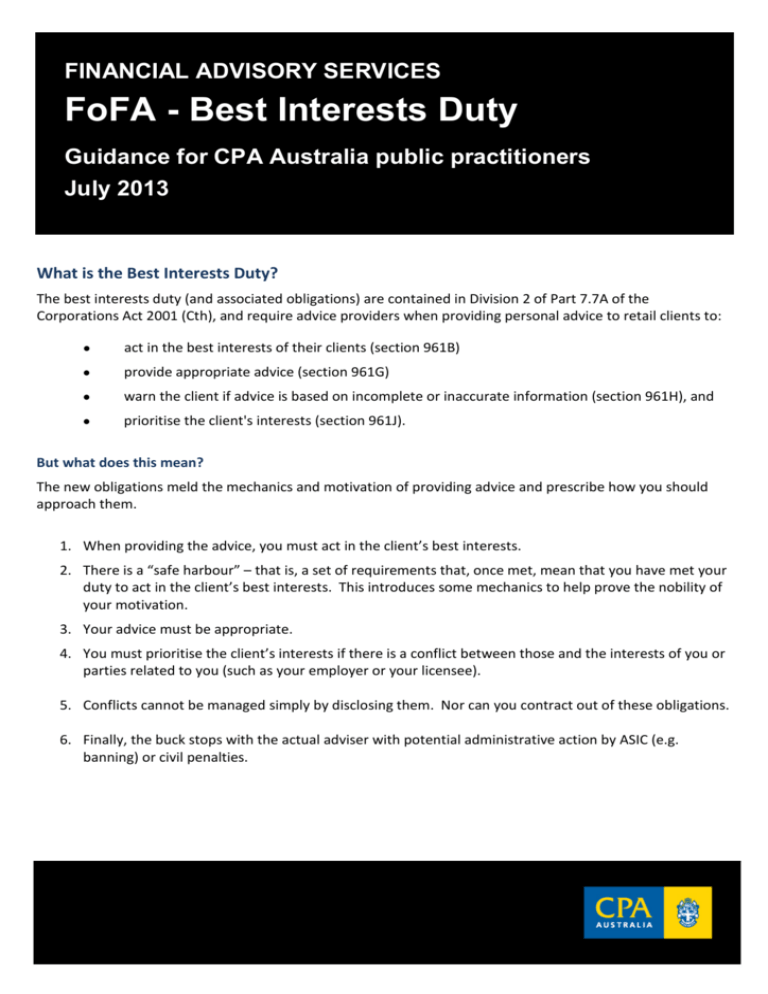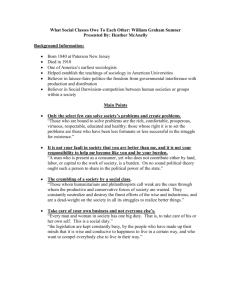FoFA - Best Interests Duty
advertisement

FINANCIAL ADVISORY SERVICES FoFA - Best Interests Duty Guidance for CPA Australia public practitioners July 2013 What is the Best Interests Duty? The best interests duty (and associated obligations) are contained in Division 2 of Part 7.7A of the Corporations Act 2001 (Cth), and require advice providers when providing personal advice to retail clients to: • act in the best interests of their clients (section 961B) • provide appropriate advice (section 961G) • warn the client if advice is based on incomplete or inaccurate information (section 961H), and • prioritise the client's interests (section 961J). But what does this mean? The new obligations meld the mechanics and motivation of providing advice and prescribe how you should approach them. 1. When providing the advice, you must act in the client’s best interests. 2. There is a “safe harbour” – that is, a set of requirements that, once met, mean that you have met your duty to act in the client’s best interests. This introduces some mechanics to help prove the nobility of your motivation. 3. Your advice must be appropriate. 4. You must prioritise the client’s interests if there is a conflict between those and the interests of you or parties related to you (such as your employer or your licensee). 5. Conflicts cannot be managed simply by disclosing them. Nor can you contract out of these obligations. 6. Finally, the buck stops with the actual adviser with potential administrative action by ASIC (e.g. banning) or civil penalties. From a technical legal perspective, the way the FOFA legislation is drafted means that you actually have three separate duties: • a duty to act in the client’s best interests • a duty to provide advice that is appropriate, and • a duty to prioritise the client’s interests in the event of a conflict. How do I comply with the best interests duty? The “how to” of fulfilling your duty to act in the client’s best interests is found in the “safe harbour” provisions. This “how to” is similar to the way the law worked before but: a) the emphasis is wholly, instead of only partly, on the client’s interests, and b) there is greater emphasis on gathering more information about the client and, if relevant, the product. How do you find yourself in the safe harbour? To find yourself in the safe harbor you must: a) identify the objectives, financial situation and needs of the client that were identified through instructions b) identify the subject matter of the advice sought by the client (whether explicitly or implicitly) c) identify the objectives, financial situation and needs of the client that would reasonably be considered relevant to the advice sought on that subject matter d) if it is reasonably apparent that information relating to the client’s relevant circumstances is incomplete or inaccurate, make reasonable enquiries to obtain complete and accurate information e) assess whether you have the expertise to provide the advice sought and, if not, decline to give the advice f) if it would be reasonable to consider recommending a financial product, conduct a reasonable investigation into the financial products that might achieve the objectives and meet the needs of the client that would reasonably be considered relevant to advice on the subject matter and assess the information gathered in the investigation g) base all judgments on the client’s relevant circumstances, and h) take any other step that, at the time the advice is provided, would reasonably be regarded as being in the best interests of the client, given the client’s relevant circumstances. If I think have a conflict – what should I do? In relation to the duty to prioritise the client’s interests in the event of a conflict, ASIC has said in RG 175: • the recommendation of the product of a related party must be supported by extra benefits for the client, and • if your APL contains only products of a related party, you must not recommend one over a competitor’s product unless a reasonable adviser would be satisfied it was in the client’s interests to be recommended that product over a rival product with similar features and costs. Your overall approach to the three new duties should be informed by ASIC’s view that ‘a reasonable adviser should believe that the client is likely to be in a better position if the client follows the advice’. Let’s put this into practice Consider whether the adviser in the following situation has complied with their best interests duty. Anna Robic has a portfolio of managed funds with Acme Platform. The reporting is ‘clunky but OK’. She is concerned about fees. Her adviser recommends switching to Perfect Platform because the reporting will be much easier to follow. The fees are higher than her existing platform by 0.1% of assets under administration. What about in this next situation? Cecil Poole comes to his adviser wanting to review his term life insurance. He has an existing death benefit of $500,000 and needs $600,000. His adviser’s recommendation is to take out a new policy for $600,000, with terms that are otherwise very similar to the existing one. The adviser receives a commission on the $600,000 policy rather than commission on a $100,000 increase. When considering situations such as these and ones arising in your own practice, use the following tips. 1. 2. Avoid “cookie cutter” advice. Ask yourself: a. Did I get to know the client? b. Did I clearly define the advice task I was asked to do? c. Am I competent to give the advice? c. Did I gather all the information I need to carry out the advice task? d. Did the advice address the goals and objectives of the client? e. Did I put the client’s interests first? These tips should be familiar to you after years of operating under the current regime. But there are two more questions you should ask yourself to ensure that your advice meets the requirements of the best interests duty and its associated obligations: 1. Would a reasonable adviser believe that the client is likely to be in a better position by following my advice? 2. If this client was my son or daughter being influenced by my advice and trusting me to act in their best interests, is this what I would recommend? Best Interests Duty Checklist Question 1. Do I comply? Yes / No What do I need to get FoFA ready? The following references are relevant to each obligation. Do I (and our representatives) understand what acting in the client’s bests interests means? • Read RG175.201-403. • Provide practical training to advising representatives. 2. What have I done to train me and our representatives? • Review each representatives training plan to ensure that they have undertaken ‘best interests’ training. 3. Am I and our representatives going to rely on the safe harbour provisions? 4. If yes to 3, do I need to bring in a new compliance procedures? What will they look like? • You will need to amend your compliance manual/procedures to take the new steps into account. 5. If no to question 3, do I and our representatives know how to comply with the bests interests duty requirements? Have I identified relevant conflicts of interest which will impact on discharging the best interests duty? Do our monitoring and supervision arrangements check that me and our representatives have complied with the best interests duty? Do me and our representatives know what to do if they are not sure they are complying with the bests interests duties or have questions about meeting the obligations? Do I and our advisers know how to provide scaled advice and also meet the best interests duty? • Develop processes to ensure best interests obligations are discharged. • Provide training on best interests. • Review your conflicts of interest policy, framework and register. • Review monitoring and supervision procedures, including checklists. • Ensure compliance manuals include best interests explanations and advisers have access to compliance support to ask questions. • Read RG175:391-395 and RG244:50-98. • Conduct training on providing scaled advice. • Review compliance resources available to advisers. 6. 7. 8. 9. Copyright © CPA Australia Ltd 2013 DISCLAIMER: CPA Australia Ltd has used reasonable care and skill in compiling the content of this material. However, CPA Australia Ltd makes no warranty as to the accuracy or completeness of any information in these materials. These materials are not intended to be advice, whether legal or professional. All names, figures, solutions and scenarios are fictitious and have been established for training purposes only. You should not act solely on the basis of the information contained in these materials as parts may be generalised and the application of exercises, examples and case studies may vary from organisation to organisation and may apply differently to different people and circumstances. Further, as laws change frequently, all practitioners, readers, viewers and users are advised to undertake their own research or to seek professional advice to keep abreast of any reforms and developments in the law.








![(NPD-60) []](http://s3.studylib.net/store/data/007320126_1-47edb89d349f9ff8a65b0041b44e01a8-300x300.png)
